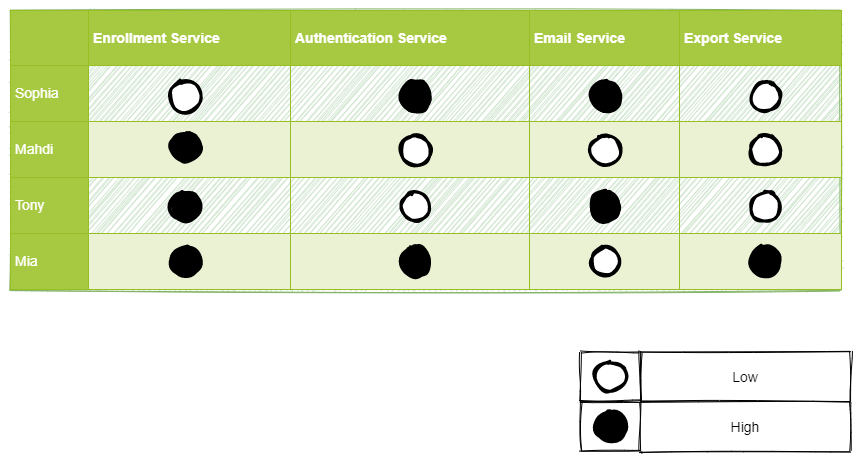Whether you are taking over new teams in an organization or you wish to know more about your team members, you can use a Skills Matrix to identify the gaps in your teams knowledge or skills. This short post explains what a Skills Matrix is and how you can build one to mine the hidden opportunities and strategize your approaches toward different initiatives.
What is Skills Matrix?
As the name suggests, Skills Matrix or Competency Matrix is a table which contains every team members’ skills proficiency level in certain area. Team members, or Players as I would like to call them, and Areas of Expertise are the two dimensions of the training matrix. You can capture the level of proficiency in each cell. Depending on your need, you can construct multiple tables, each targeting different sets of skills or area of knowledge.

This is a simple example of a Skills Matrix which measures the knowledge of 4 team members in a system across different services in a binary format. Mahdi is only familiar with Enrollment Service and Mia is the only person who knows Export Service very well. It is also evident that Export Service requires some attention and this is usually considered a risk which needs to be addressed soon.
How to fill up Skills Matrix?
You can fill up the Skills Matrix yourself. But to truly utilize its potential, ask each team member to rank their own knowledge and skills in different areas. You can also change the format from binary to numbers or any abstract measurement units like T-shirt sizes. At bigger scale, you can rolled up the result to a higher level by defining different sets of players. In this case, use teams instead of individuals.
You can think of the players level of proficiency as a state with a predefined set of transitions between them. In our binary example, we have two states and one transition between Low and High. The more proficiency levels you define, the more transitions you will end up having in the Skills Matrix. Whether your transitions are sequential or not is completely up to you. In our context, these transitions are the actions needed to be taken to enhance a player’s level of proficiency, for example, taking an online course or conduct a knowledge transfer session from other experts in the field.

Good practices
Here is my recommendation when it comes to using Skills Matrix in your organization:
- Rating: It is crucial to ask the players to rate their level of proficiency. Yes, you will end up in a situation where you might not necessarily agree with someone’s rating. That is perfectly fine. Afterall, if someone believes he/she is the best in certain area, you cannot expect that person to improve in that area any further. Their perspective needs to be corrected and that is a different challenge.
- Goal: Always start with clearly communicating your intentions to the team and what you expect to find in the outcome.
- Privacy: If you decide to publish the result to everyone in the organization, make sure to consider the individuals privacy. Communicating the format and how the Skills Matrix result will be shared ahead of time helps the players set their expectations beforehand.
- Cadence: If you wish to monitor your progress, which I highly recommend, you can repeat the process over a certain period of time. It goes without saying the format is best to be consistent throughout the whole measurement. To determine how frequent the measurement should be done, you should look at the transitions and pick the one that requires least amount of time to complete.
- Calibration: When a Skills Matrix is used at bigger scale, you might need to adjust different units of measurements. For instance, players can rate themselves using abstract units of measurements like T-shirt sizes. But at higher level, a number could represent the number of players at a specific state.
Improve your Skills Matrix
Finally, here is an example of a good Skills Matrix with one golden bonus recommendation (interest):

A great way to identify the opportunities across multiple teams is to ask people for their interests in different areas of expertise. In this example, Tony has shown interest in learning Java and Mia could be a candidate to teach him how to code in Java. Sophia says she has no interest in Java, but could that be due to lack of knowledge about Java? She seems to not be interested in .NET even though she is very good at it.
We learned what a Skills Matrix is and how it can be used in an organization to identify knowledge gaps across different teams. By capturing people’s interest as a separate column in our matrix, we can easily find potential areas of growth in our teams.
Special thanks to Sheryl Basbas for helping me with proofreading this article.





My dear Mahdi
Its a very impressive essay to empower our abilities and achieve our goals in management. I wish for you the best successes in this important issue..
This is a vsry good article mehdi. The way u have defined the matrix is very intresting anc i can find my own knowledge gap in the team.